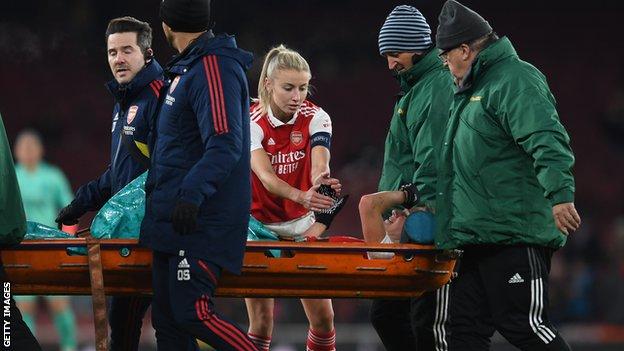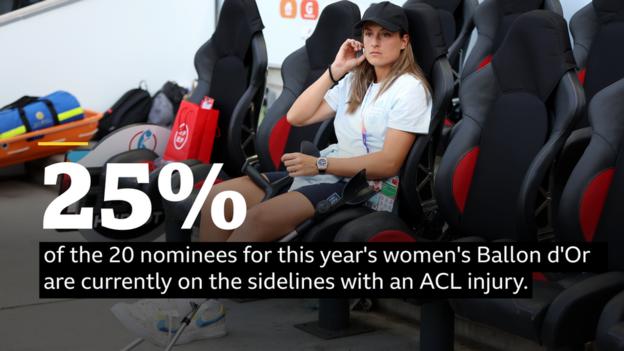
Not another.
When Arsenal striker Vivianne Miedema left the pitch on a stretcher last Thursday evening with her hands covering her face, onlookers were already fearing the worst.
Four days later it was confirmed – another of the world’s best female players had suffered an anterior cruciate ligament (ACL) injury, regarded as one of the worst injuries to have as a footballer.
The all-time top scorer in the Women’s Super League joins an ever-expanding list which includes her partner and Arsenal team-mate Beth Mead, who was the Euro 2022 player of the tournament, and the winner of the Ballon d’Or, Alexia Putellas.
Once again, there are renewed calls from players, fans and managers for more research into why this type of injury is more prevalent in female footballers than male.
England striker Chloe Kelly has said the “fear” and “negativity” around ACL injuries “needs changing”. So what is being done to try and reduce the risk?
‘No proven cause’
Research has long suggested that ACL injuries – the most serious kind of knee damage – are more prevalent in female footballers, with estimates ranging from two to eight times more likely than in male.
Dr Katrine Okholm Kryger, a senior lecturer in sports medicine at St Mary’s University in London who specialises in football, said recent discussions have focused on whether the injury risk is sex related – the female anatomy and hormones, or whether it could be gender related – the way female athletes are raised and managed compared to male athletes.
“I think there’s some truth in all of these areas,” she said.
“We have to be really careful when we talk about this in women’s football because there is a tendency within research and within the media of being like ‘oh, women are so unstable, fragile, because of their anatomy, their hormonal fluctuations’ but we haven’t proven that is the cause of these injuries.
“Maybe it is the way we’re treating women. I’d like to see that changed in people’s perceptions of female athletes and women’s football in general.”
What are the main areas of concern?
1. Anatomy/biomechanics
The physical differences between men and women, such as women generally having wider hips, which increase the leg’s angle into the knee, and under-developed muscles which prevent the knee from turning in upon landing, have been the subject of research looking at whether that increases the risk.
However, Dr Okholm Kryger says that there is no strong evidence from the research that this is the main risk factor.
2. Hormones
The role of the menstrual cycle has also been put forward as potentially making females more predisposed to injury at certain times. During the menstrual cycle when oestrogen is elevated, which usually happens in the second week, it can affect the stability of joints, making them looser and more lax.
However, Dr Okholm Kryger is keen to stress that there is a lack of research to support whether this increases the risk of injury. “There has been some not very high quality research done on the relationship between the menstrual cycle and the ACL risk,” she said. “It’s very difficult because you need either continuous blood samples or saliva.
“Most of it is done predicting where in the phase women are, based on when their period starts, most studies haven’t actually measured hormonal levels in the body. So it’s all predictions. When you put all the data together it shows very little difference.”
Dr Okholm Kryger also pointed out players often report that they are more likely to get injured when they are on their period at the start of their cycle, but actually the risk should be higher during ovulation.
3. Gender disparities
A 2021 study published in the British Journal of Sports Medicine suggested looking at the influence of gender – pointing at external factors such as access to training, sport science, facilities and rehabilitation.
Female footballers are likely to have significantly lower training ages – the amount of time and exposure an athlete has had to structured, coached and progressive training – compared to their male counterparts.
Other gender disparities highlighted by Dr Okholm Kryger include the pitches used in the WSL compared to the Premier League and the design of football kit such as boots. Women move and run in a different way to men and yet the length of studs on boots are designed around male movement and traction, she pointed out, which increases the risk of women getting their boot stuck in the surface and an injury being caused.
4. Workload
As women’s football grows rapidly, the amount of games and the level of intensity is also growing quickly, which is leading to increasing concern among managers and players in the game.
“Obviously you can do everything to put the players in the best condition possible but with the volume of games and the limited recovery time at the moment, it’s difficult to do anything about it,” said Dr Okholm Kryger.
Why are ACL injuries so serious?
Northern Ireland striker Simone Magill had waited her whole career for 7 July, when her country made their debut at a major tournament at Euro 2022.
But 79 minutes into her side’s first game against Norway, the dream was cut short.
“I went to stick my leg out to balance, and as soon as I stuck my leg out, I literally felt the ligament pull away from my leg so I knew straight away it wasn’t great.
“It was horrendous. I was a mess.”
Magill, 28, was helped by being surrounded by eight international team-mates who had gone through it before her.
“They were brilliant in terms of reassuring me. They were all examples to me that they had had it, gone through it and come back.
“I had no idea the things you have to go through. I heard about so many people doing [their ACL] but I didn’t actually know what that involved.”
What makes the injury so difficult is the longevity, she said, as well as having to learn the mechanics of walking again.
“I completely forgot the natural way you would walk. I was having to learn that in the house, standing in front of a mirror and just focus on doing knee to toe, I had no idea that would happen!
“I just assumed I would get surgery, be sore for a week or two, and then it would all come back to me.
“It was the mental side of all that. I kept thinking, it’s not my knee, it doesn’t feel like my knee. Will it ever feel like my knee again?”
Magill’s ACL injury wasn’t even the first of the European Championship, with Spain star Putellas having been ruled out on the eve of the tournament, while France’s Marie-Antoinette Katoto would later become the third player to suffer it.
“Now I’ve started to reflect on it, I definitely think that there’s underlying reasons why it happened,” said Magill. “It’s not just ‘oh it’s part and parcel of the game and we have to accept it’.
“The rate it’s happening at the minute it’s actually frightening.”

What is being done to try and reduce risk?
Dr Kryger works closely with a number of WSL teams, as well as the England team, and she said clubs know ACL injuries are “the biggest problem in women’s football at the moment because of the recovery time and the potential long-term impact on a player’s career”.
But while they are desperate to see improvements, knowing how to tackle it is more difficult.
BBC Sport has been told one WSL club has recently recruited professionals to further research on ACLs as the game is still growing and adapting to increased professionalism.
Dr Andrew Greene, a senior lecturer in biomechanics at the University of Roehampton, is a keen advocate of trying to implement injury prevention programmes at women’s football clubs.
Before he also became head of performance at women’s Championship club Crystal Palace, he contacted every Championship club and some WSL sides about implementing a neuromuscular programme, aimed at targeting weaknesses in athletes.
He said: “What they are designed to do is address the underlying mechanical issues that we know contribute to the injury, and are the factors that we know are present in female athletes.”
He gave an example of the hamstrings which he said tend to be an under-activated muscle group in female athletes.
Palace engaged with the idea because two of their players had suffered ACL injuries in the previous year.
Dr Greene said: “If we can go back a step and make sure the athletes are more prepared for the intensity of a game and they are used to stopping, starting and changing direction in a controlled environment, those underlying capabilities are there and will assist in stabilising the joints and reduce the risk.
“In the female game, while the facility of gym and conditioning programmes is getting far better, I still think in the Championship, the access to the gym is quite limited for the players. Reliance on a once a week gym programme is not sufficient.”
The Football Association (FA) has conducted a study into the prevalence of ACL injuries in women’s football in the WSL and the Championship over the past four seasons.
Its results, which are due to be released in full in the new year, have shown that there were 0.1 injuries per 1,000 hours – 0.4 ACL per 1,000 match hours and 0.04 ACL injuries per 1,000 training hours – representing 1.3% of the total number of injuries. Hamstring injuries were the most common at 11%.
The FA, which does not have the equivalent data for men’s football, said in a statement: “The overall injury rates across these leagues have decreased in the past four seasons, however we will continue with our injury and illness surveillance work, which will continue to give us important medical insight into women’s football.”
What more needs to be done?
Research, research, research.
Speaking to players, managers and academics, they all agree that there has not been enough research into the causes of ACL injuries.
Tottenham manager Rehanne Skinner, speaking earlier this season after seeing two of her players suffer the injury, said: “Clearly the demands of the game are changing and we need to understand what that involves.
“I still don’t think there’s enough research available for us to formulate collectively in the women’s game the best possible plan moving forward.”
Dr Okholm Kryger wants more large-scale research. She said: “A lot of the data that comes out is from one club. ACLs happen too often but luckily you don’t have many of them in a season. So if you only have data for one club or national team, it’s only very limited amount of data that you’re going to get.”
She is currently in talks about setting up more research and is hopeful of getting the funding needed.
One doctor, who formerly worked at a WSL club and didn’t wish to be named, said he wanted to see the whole football community pushing for equity of access to resources for female players – whether that’s coaching, sport sciences or access to facilities, starting at academy level.
“The challenge, for the women’s game across the board, is to get that kind of support that men get,” he said. “What you have in the women’s game is that support staff aren’t paid particularly well, so that means you’re not maybe attracting the best.
“And the resources – at the highest level of the women’s game, it wouldn’t have a fraction of the number of staff that a very average men’s team or very average men’s academy would have.”



